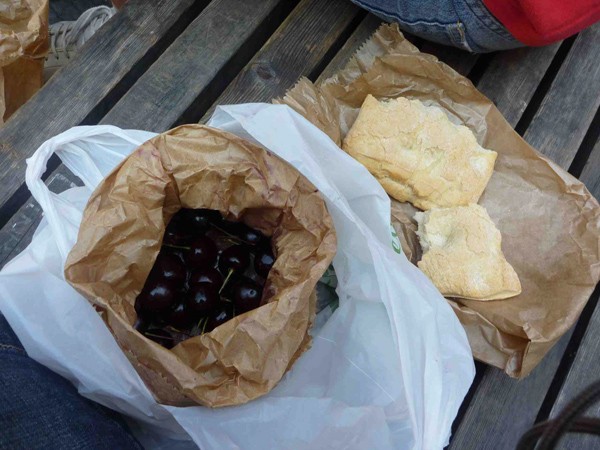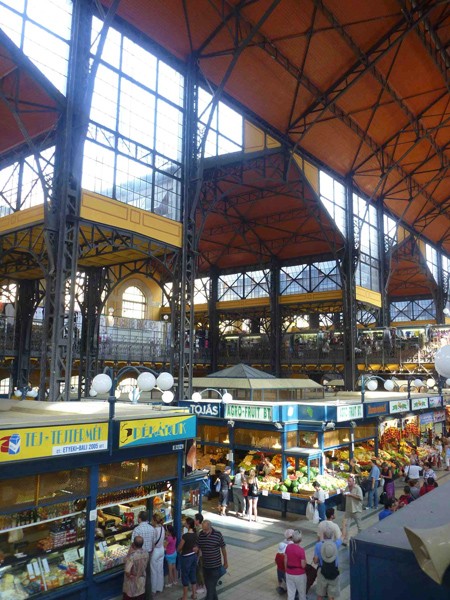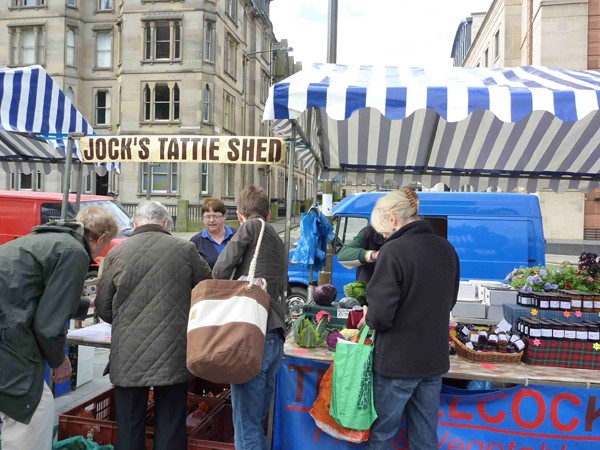Jean McBain writes: Andrew and I decided to spend our first year of married life travelling in Europe. Something we’ve always looked for in our travels is interesting food experiences and over the last ten months we’ve certainly had some memorable meals, both for good reasons and bad (one word: airports).
Sometimes self-catering means you get the best view.
Throughout our trip we’ve done a lot of self-catering. This is good for the budget, but food shopping is also a great entry point into a new country or culture. Strolling through markets, grocers and supermarkets across Europe has been fascinating and challenging at times.
That’s the introduction, now for the preface (wrong order I know!)
I grew up on an almond farm. My Mum grew a lot of our own vegetables and my first job was helping on our stall at the Willunga Farmers Market (the best farmers market in Australia). Buying seasonal, local produce is therefore not so much a philosophy for me as a habit. In recent years I’ve also started to learn about, and consciously identify with, the sustainable food movement.
What this all boils down to is that shopping for food is something I think about, something I pay attention to. So here are some of the experiences and challenges we’ve come across in food shopping across Europe. The focus is fruit and veg, but maybe another day I’ll step into the joys and challenges we faced shopping for meat and animal products here.
Italy
Our trip began in the north of Italy, where we spent three months with family. For anyone inclined towards a food philosophy that favours seasonal and local produce the Italian markets are a heaven of abundance and variety. You might think you know tomatoes or zucchini, but your average market gardener in Italy will be able to introduce you to a whole new world of shapes, varieties and flavours.
Lunch from a Florentine market.
The depth of variety aside, the kind of seasonal eating and types of produce available in the Italian summer weren’t that far a stretch for us southern Australians. We spent the summer gorging ourselves on melanzane (eggplant), tomatoes, zucchini and other summer favourites like the omnipresent melone(rockmelon).
Eastern Europe
The next part of our journey found us in the former soviet-block countries of Hungary, the Czech Republic, Poland and Lithuania. Suddenly trips to the shop became fraught with difficulty. I won’t even get started on the appalling excuse for milk which is the norm in that part of the world, but on our daily trips to pick up some fruit for our lunch or veg for our dinner I kept coming up against the same question: “What’s fresh at this time of year? What should I be eating in a central-European autumn?”
The Great Market Hall (Központi Vásárcsarnok) in Budapest.
Suddenly this question made me recognise the feeling I’d begun to have of being thrown completely out of the cycle of seasons. This had naturally begun with our two summers in a row — one in Adelaide and then the second in Italy — but the problem was greater than that. To put it simply, Polish Autumn is not the same as Australian Autumn. My seasonal instinct was thrown completely out and I didn’t know if it was time for apples or oranges, kiwis or cumquats. This was disorienting in a way that was completely unexpected.
Britain
In Britain we encountered another challenge in the labyrinthine megamarts that dominate the food supply there. In these, the food marketing and eat everything all-year-round ideology stripped away several tools in my shopping strategy. Imported produce dominated the shelves and mountains of packaging intruded between the fruit and my senses of smell and touch.
Feeling all at sea in this strangely sanitised version of groceries, the usual reaction was to just buy what we felt like eating, and deal with the disappointment with its tastelessness or false promise at a later hour.
At the Edinburgh Farmers Market.
Despite the respite of perfectly ripe raspberries and some truly delish veg bought from smaller grocers or farmers markets, I departed Britain feeling like my internal grocery clock wasn’t going have a chance of getting back in sync until we were back in Australia.
Paris
But then we went to Paris. Three weeks in Paris in November was mostly heaven, with the only down point being the two days I spent in bed with a bad cold. Through those two days, however, I received the best medicine a head cold could hope for — mountains of perfectly ripe, sweet and juicy mandarins. As the weather got colder, suddenly the citrus started asserting its presence and the French, knowing what’s good for them, embraced the first appearance of mandarins and oranges with celebration.
Our kitchen in Paris.
After recovering from my ailments I was able to accompany my nurse (husband) to the local green-grocer. There we happily select from the five or so varieties of perfectly ripe vegetables on offer and picked up another few kilos of citrus. Thus supplied we carried our loot home and filled our tiny apartment with the smell of soup-making and sautéing. Food shopping was suddenly simple again.
Belgium and beyond
That winter love-affair with our citrus friends reinforced for me why buying seasonal food matters. Moving from the increasingly cold Paris to the even colder Belgium, the burst of colour and Vitamin C offered by oranges or mandarins was a vital part of most of my days. In the office, my Belgian colleagues charmed me with stories about receiving mandarins for Christmas in their youth.
Unfortunately Belgium did mean a return to supermarket shopping and a return to one vexing question — where are the ‘local’ boundaries in a European context? I don’t think twice about buying bananas from Queensland at home in Adelaide — but they travel just as far as capsicums do from Spain to Belgium. Is that ok? I’m still not sure.
Fortunately I don’t have to work that out right now. We’re back in Italy, it’s finally Spring, and the markets are just down the road. I can’t wait to see what we can buy.
This post first appeared on Jean’s blog Hollow Legs, Hungry Mind.












Crikey is committed to hosting lively discussions. Help us keep the conversation useful, interesting and welcoming. We aim to publish comments quickly in the interest of promoting robust conversation, but we’re a small team and we deploy filters to protect against legal risk. Occasionally your comment may be held up while we review, but we’re working as fast as we can to keep the conversation rolling.
The Crikey comment section is members-only content. Please subscribe to leave a comment.
The Crikey comment section is members-only content. Please login to leave a comment.